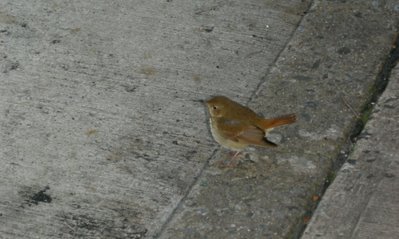
PHOTOGRAPHS: DONEGAL BROWNE
I'd been trying over and over to get a clear picture of her, without much success as you can see. She'd fly across the Bird Park to the stand of grasses and I'd stealthily walk around the outside of the fence trying to poke the lens of the camera through the "right" hole in the chain links. Just about the time I'd about got her in frame, she'd fly to the other side and gobble some "red" berries off the evergreen. I'd head that way and off she'd go again. She was almost as bad as the Juncos.

Then suddenly she was just there, standing on the sidewalk.

She gave me a look, cocked her tail, flicked her wings, and

trotted briskly, tail still perked, across the street to the curb dividing the two ramps.

Handily, she hopped up, began to walk down the median,

and once past the dividing wall, Mrs. Thrush looked both ways, proceeded across the second street, walked through the fence, and onto the grass inside the traffic circle. Truthfully she appeared quite full of purpose.

Then suddenly gone, lost to sight when a bus came rumbling by.
Goodness. I do hope she isn't planning on walking all the way to Guatemala.
16 comments:
Lincoln Karim has solved the problem. The browntail is the adopted child of Palemale and Lola. Browntail, by name, is even stitting in Palemale's favorite tree.
So, then we have an adopted child. Imagine though being able to sit in Palemale tree.
anne
My day is made lovely simply by thinking of your thrush walking to Guatemala.
As to Browntail as adopted offspring, to be anthropomorphic perhaps the reigning RT monarchs have missed the company of their own young. :-)
Which brings up something else, I've never been fully convinced that at the very least some of their male progeny didn't abide in the Central Park for longer than what is considered usual in territories of lower prey concentration. Particularly as Palemale and Lola so often were seen flying leisurely in circles with a third or even forth Red-tail during the interlude before the next breeding season came round.
Then there was the incident last nesting season when, while Lola sat the nest, a visiting RT appeared and landed on the eve of 927, just right of the nest bowl. Pale Male appeared in a flash, but instead of going in like a Valkyrie he landed center on the eve looked at the visiter, puffed up, did his scary hawk menace stance, and did a little hop towards the visitor who immediately took off for parts unknown. This is not the normal reaction when visitors appear even much farther away from the nest during nesting season.
I'm convinced that the "raisin bread" theory, with Central Park being a humongous raisin, explains a real difference in Red-tail behavior here.
As to Mrs. Thrush, keep an eye peeled for an update.
Natalie Angier of the NYTimes won a Pulitizer Prize for not worrying about being anthropomorphic. Lanague as such makes us anthropomorphic in description, so be conscious of it and do it right.
http://www.nytimes.com/2004/10/26/science/26croc.html?ex=1256443200&en=c194455917eeb25c&ei=5090&partner=rssuserland
October 26, 2004
Not Just Another Pretty Face
By NATALIE ANGIER
WASHINGTON - To the casual observer, an adult alligator afloat in an algae-dappled pond, its six-foot body motionless save for the sporadic darting of its devilish amber eyes, might conjure up any number of images, none of them fuzzy-wuzzy. A souvenir dinosaur. A log with teeth. A handbag waiting to happen.
For Dr. Daphne Soares, however, a neuroscientist at the University of Maryland, an alligator looks like nothing so much as a big, amphibious and grievously misunderstood kitten. Sure, it sports thick scales and bulging bony knobs called osteoderms rather than fur, and 80 teeth to the house cat's 30, and a tail that, as Dr. Soares learned from personal experience, can dislocate your jaw with a single whack.
But just look at the chubby belly, the splayed legs, the sunny smile that never sets! "Oh, you are so cute, so adorable, I wish I could just pick you up and give you a hug!" Dr. Soares cooed to the alligators that obligingly posed for her at the National Zoo here on a recent weekday afternoon.
Dr. Soares, 32, who was raised in Rio de Janeiro by a Brazilian mother and an American father and who conveys a blend of high energy and droll ease, has worked with many species of Crocodylia, the reptilian order that includes crocodiles, alligators, caimans and gharials. And while she admires the entire crocodilian dynasty, alligators are her favorite. "I absolutely love these creatures," she said. "They're beautiful, elegant and goofy at the same time."
They are also unmistakably observant, and as curious as, well, kittens. When Dr. Soares took a seat near the glass of the enclosure, the alligators paddled over for a close-up view. "They get a bad rap for being stupid little reptiles," she said. "But they're very curious, very alert, and they want to know what's going on."
In fact, the reptiles are virtual newshounds, for whom the term "current events" holds particular meaning. Dr. Soares, who specializes in neuroethology - the neural underpinnings of animal behavior - has lately discovered a kind of sixth sense unique to crocodilians, which are often referred to generically as crocodiles.
She has determined that the mysterious little bumps found around the jaws of some crocodile species and across the entire bodies of others, which naturalists had long observed but never before understood, are sensory organs exquisitely suited to the demands of a semisubmerged ambush predator....
http://www.nytimes.com/2006/11/05/arts/music/05oest.html?ex=1320382800&en=5664a4904458498f&ei=5090&partner=rssuserland&emc=rss
November 5, 2006
A Pianist Harmonizes With Wolves
By JAMES R. OESTREICH
WHEN the French pianist Hélène Grimaud was living in Tallahassee, Fla., in 1991, she took a friend's dog for a late-night walk that ended up changing her life. She saw a neighborhood loner and his animal approaching in silhouette. The creature walked in a way she had never seen — tense and furtive — and caused her dog to disappear into the brush for 45 minutes.
It was her first encounter with a wolf (part she-wolf and part dog, she now says, "probably not a real wolf"), and the chemistry was immediate.
"She came up to my left hand and sniffed it," Ms. Grimaud writes in her memoir "Wild Harmonies: A Life of Music and Wolves." "I merely stretched out my fingers and, all by herself, she slid her head and then her shoulders under my palm. I felt a shooting spark, a shock, which ran through my entire body. The single point of contact radiated throughout my arm and chest, and filled me with gentleness, ... a most compelling gentleness, which awakened in me a mysterious singing, the call of an unknown, primeval force."
"I had fallen in love with this she-wolf," she writes later.
For centuries if not millennia, as Ms. Grimaud establishes in her book, wolves have been subjects of vilification and myth, to say nothing of attempts at eradication. But she does not see them as villains. She sees them not only as essential "biodiversity engineers" in preserving balances among animal and plant species but also as endlessly fascinating creatures who have much to teach humans. And she is on a mission to change their image....
So, when being bullied about being anthropomorphic, bully back. Now, about walking to Guatemala and Lola thinking of having a fling or just paying with the grandchildren....
As far as alligator hugging goes though....
Does anyone remember who said, "Those who criticize anonymously, not only lack courage but also the gumption to have any convictions in the first place."
Portia
I thought Natalie Angier got a Pulitzer for Beat Reporting in 1991 not anthropomorphism.
And there would be scientists that would dispute that in science there are not specific ways to describe creatures and events, yes, with language, that do not include anthropomorphic bias. Boring to many, but not imbued with the thoughts, intellect, or emotions of humans.
And by the by, the word is not spelled lanague, if the one you're searching for is language.
Okay, okay, as there are sooooo many anons on the page, I'll count down. To the fourth anon, seriously, just so I understand what we're specifically talking about here, just what does "doing it right" entail? As in which "it" are we talking about, and a definition of "right" would help me understand what's being referred to as well. Thanks.
My, oh, my. Imagine, here I am enjoying the lovely blog and adding a thought and I make the mistake of not spell-checking but preferring to spell creatively which shows how clever I am, though given the nasty comment why should I add a name though I find it clumsy to do so. Funny, I think Natalie Angier won a Pulitizer for teaching us how to write freely and wonderfully about other animals than us.
I am so criticized and so intimidated. Duh. Now, to enojy the blog. Duh.
"Language as such makes us anthropomorphic in description, so be conscious of it and do it right."
What I meant was write as the finest of biologists from Charles Darwin on have written, with the sort of elan that characterizes Donegal Browne, simply knowing that we really are not birds or wolves when we describe them.
[Again, I find writing in blogger most difficult.]
Hello Anon 10:28,
Thank you. With all the directions that the page was going in, all at once, I truly was confused exactly what you meant. This could be a fascinating conversation for the main page. Send me an email. As I'm completely paranoid about the spam possibilities I always write out the address.
The beginning is that of the name of the blog, then there is that little symbol that we verbalize as "at" then yahoo and then the first three letters of the word commercial.
Post a Comment